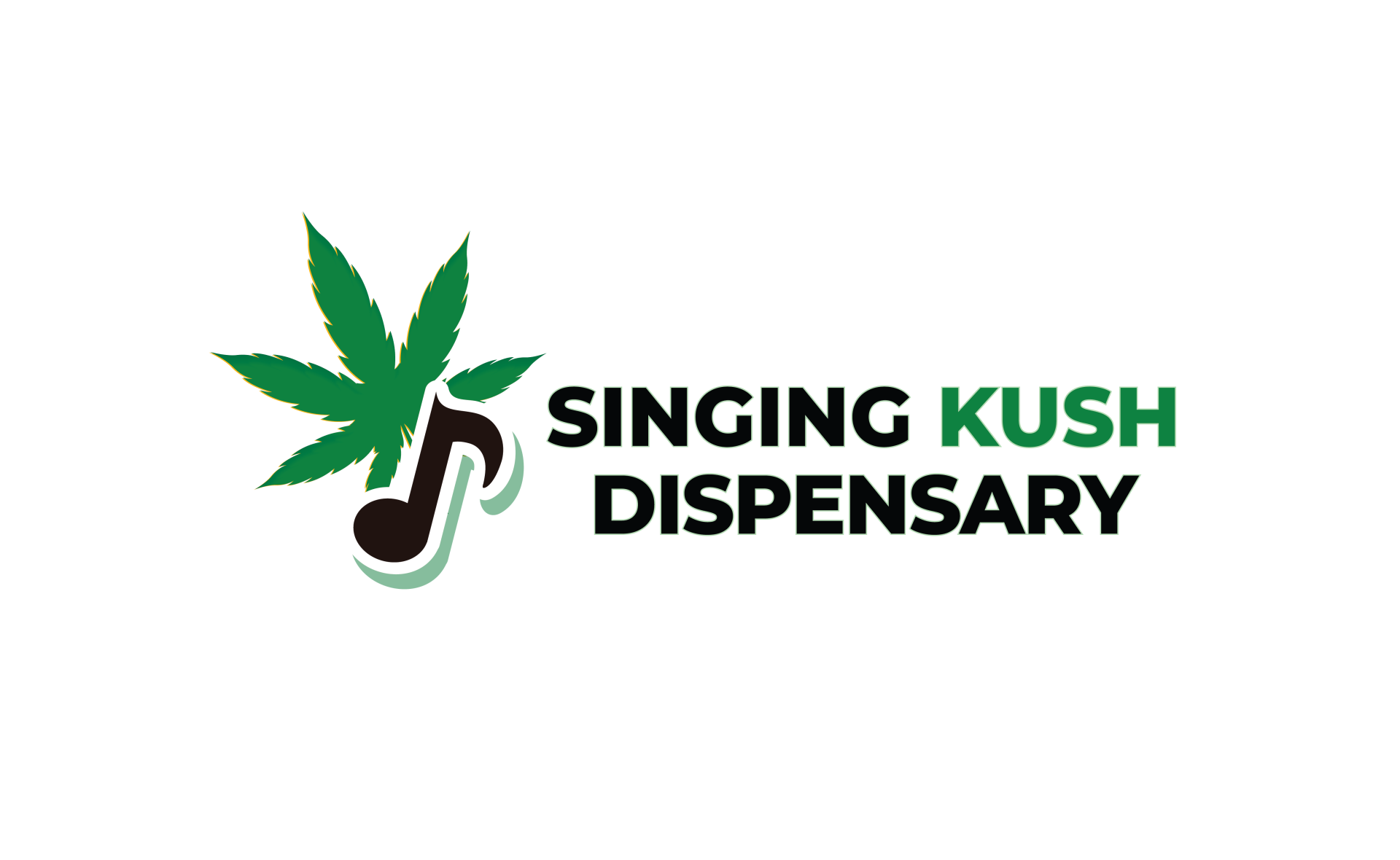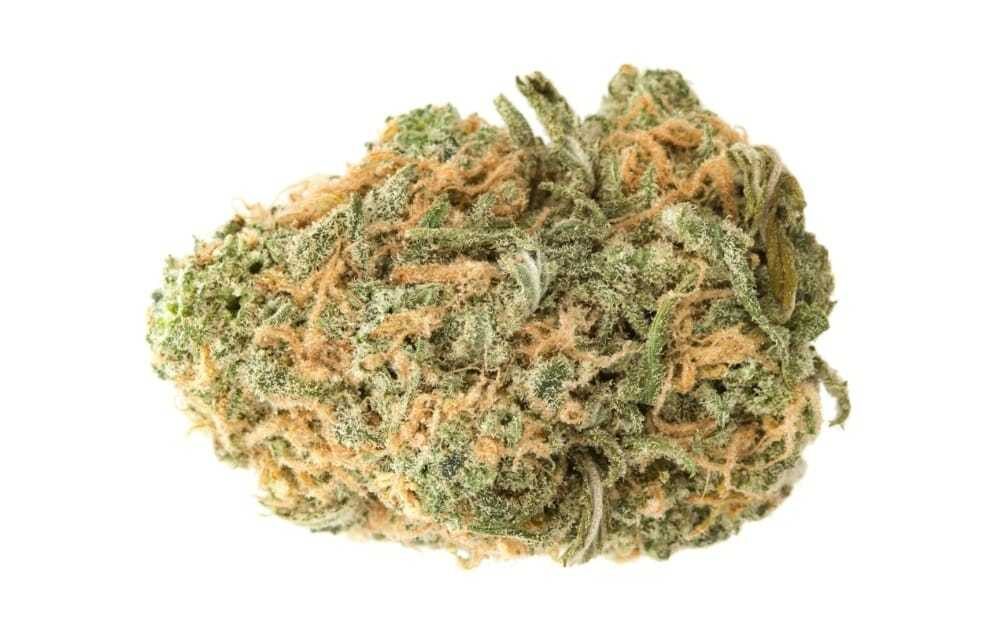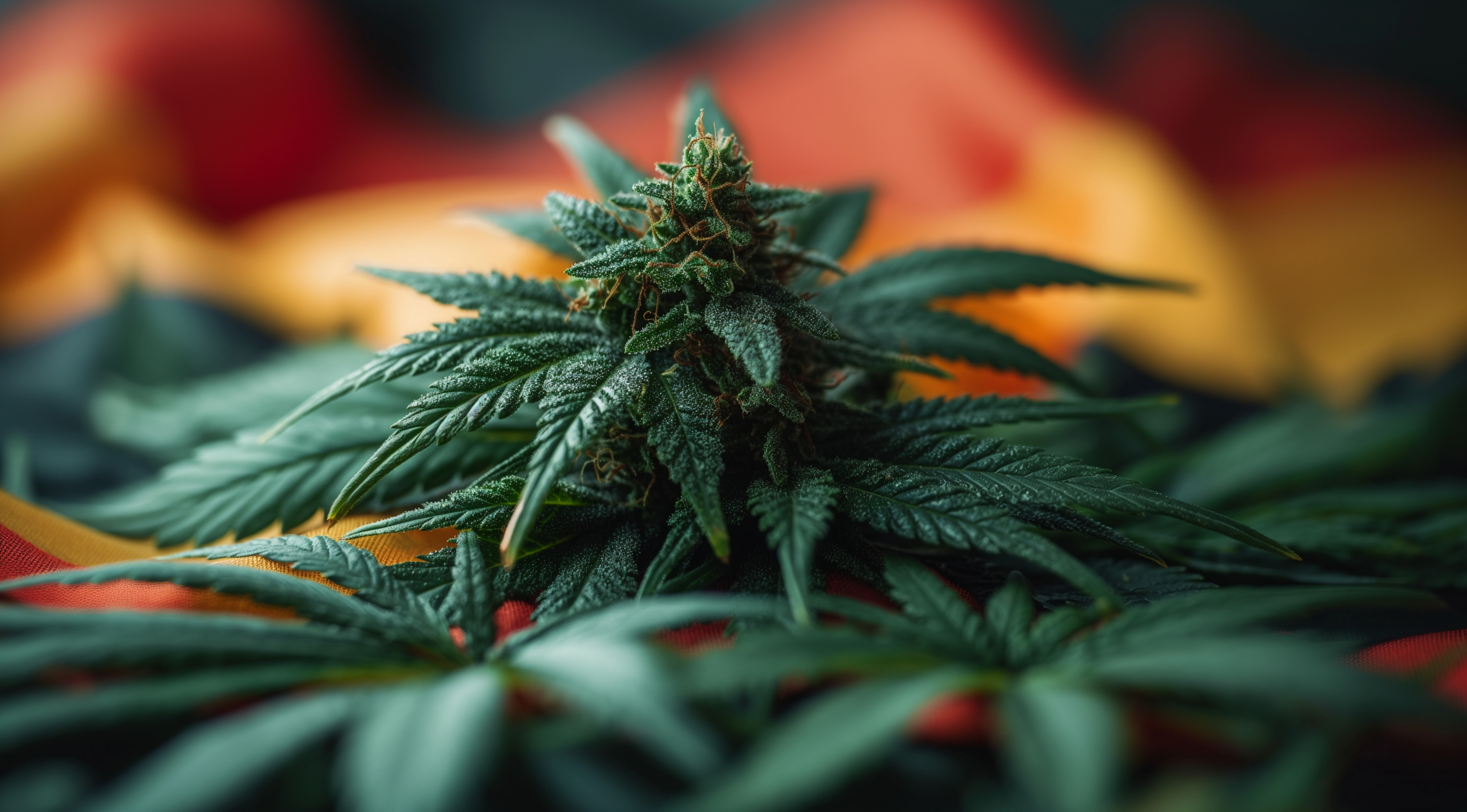The Complete Guide to Cannabis Vaping: History, Science, Benefits & How-To
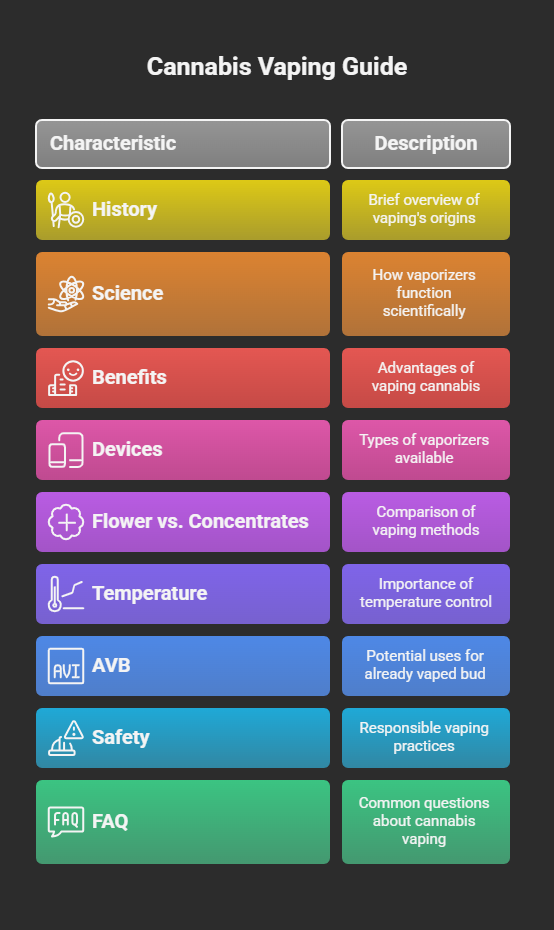
Cannabis vaping has rapidly become a preferred method for consuming cannabis, offering a smoke-free alternative that many believe enhances flavor and provides a smoother experience. Whether you’re seeking the psychoactive effects of THC or the therapeutic benefits of CBD, understanding the nuances of cannabis vaping is key. This comprehensive guide will delve into the history, science, benefits, various devices, optimal temperatures, safety considerations, and frequently asked questions surrounding this popular consumption method.
Table of Contents:
- Understanding Cannabis Vaping: A Modern Consumption Method
- A Brief History of Cannabis Vaping
- The Science Behind Cannabis Vaping: How Vaporizers Work
- The Benefits of Vaping Cannabis
- Types of Cannabis Vaporizers: Choosing the Right Device for You
- Vaping Cannabis Flower vs. Concentrates: A Comparative Analysis
- Optimizing Your Vaping Experience: Temperature Matters
- Exploring the Potential of Already Vaped Bud (AVB)
- Safety Considerations and Responsible Cannabis Vaping
- Cannabis Vaping: Frequently Asked Questions
- Conclusion | Cannabis Vaping
Understanding Cannabis Vaping: A Modern Consumption Method
Cannabis vaping involves heating cannabis flower or concentrates to a specific temperature range, typically between 300-600°F (150-315°C), which is significantly lower than the temperatures reached during combustion (smoking). This process releases the active compounds – cannabinoids (like THC and CBD) and terpenes (the aromatic molecules) – in the form of a vapor that can be inhaled. By avoiding the burning of plant material, vaping significantly reduces the intake of many harmful byproducts associated with smoke American Lung Association on the dangers of smoking. This often results in a smoother inhalation experience and allows users to discern the more subtle flavor profiles of different cannabis strains and concentrates.
A Brief History of Cannabis Vaping
The concept of vaporizing botanicals has roots stretching back centuries, with rudimentary devices used for inhaling herbs. However, the modern history of cannabis vaping is more recent. In 1927, Joseph Robinson filed a patent for an “electric vaporizer,” though it wasn’t specifically for cannabis. Throughout the 20th century, various attempts were made to create smokeless inhalation devices. Noteworthy was Eagle Bill Amato, a Native American medicine man, who popularized a portable cannabis vaporizer in the early 1990s.
The true breakthrough for cannabis vaping came with the advent of more sophisticated devices in the early 2000s. The Volcano Vaporizer, introduced in 2000 by Storz and Bickel, set a new standard for vapor quality and efficiency. The rise of e-cigarettes, pioneered by Hon Lik in 2003 as a smoking cessation tool, also paved the way for the development of smaller, more portable vaporizers for various substances, including cannabis. By the early 2010s, the market saw a surge in cannabis-specific vaporizers, including vape pens for oils and portable devices for dry herb and concentrates. Today, cannabis vaping is a multi-billion dollar industry, with a wide array of devices catering to diverse preferences and needs reputable cannabis market with New Frontier Data.
The Science Behind Cannabis Vaping: How Vaporizers Work
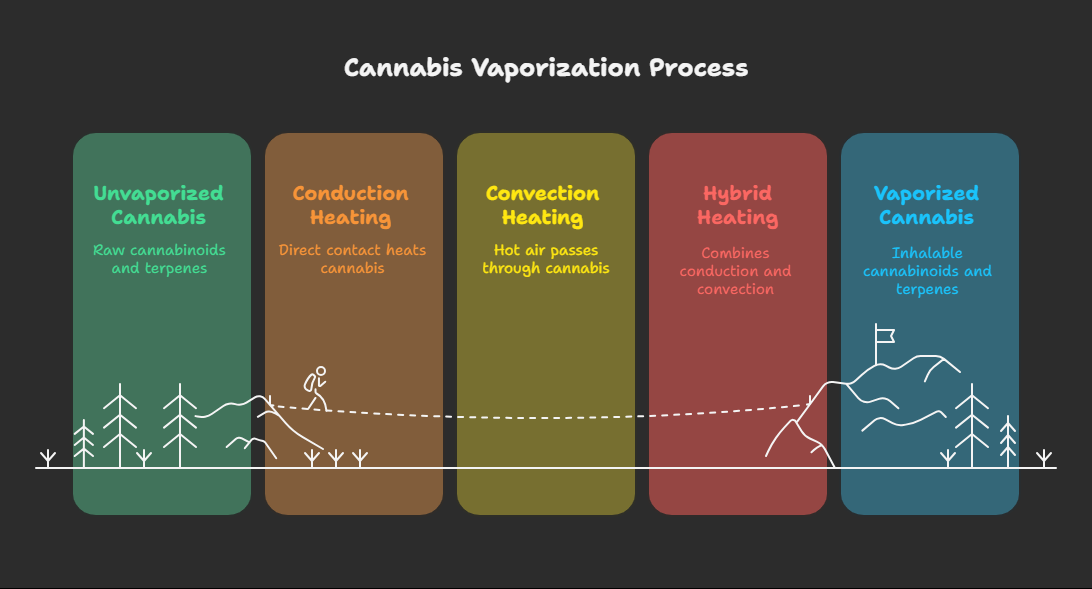
Cannabis vaporizers utilize different heating methods to convert cannabinoids and terpenes into vapor:
- Conduction Heating: This method involves direct contact between the heating element (usually ceramic or metal) and the cannabis material (flower or concentrate). Similar to a frying pan heating food, conduction allows for rapid heat-up times but can sometimes lead to uneven heating and the risk of burning if the temperature is not carefully controlled. Many vape pens utilize conduction heating.
- Convection Heating: Convection vaporizers heat the air around the cannabis material, and this hot air then passes through the material, extracting the desired compounds as vapor. Think of it like a convection oven. Convection typically provides more even heating and reduces the risk of burning, resulting in a more consistent and flavorful vapor. However, convection vaporizers often have longer heat-up times.
- Hybrid Heating: Some advanced vaporizers utilize a combination of both conduction and convection heating to achieve the benefits of both methods – fast heat-up and even extraction.
Vape pens typically consist of a battery and a cartridge filled with cannabis oil. The cartridge contains an atomizer, which is the heating element. Atomizers usually employ a wick, ceramic coil, or metal plate that heats up when the battery is activated, vaporizing the oil for inhalation. E-rigs, or electronic dab rigs, are designed specifically for vaporizing concentrates at higher temperatures and often incorporate water filtration for a smoother hit, mimicking the traditional dabbing experience.
The Benefits of Vaping Cannabis
Many users choose cannabis vaping over smoking for several reasons:
- Potential Health Advantages: By avoiding combustion, vaping significantly reduces the inhalation of harmful byproducts like tar and carcinogens present in smoke the Role of Terpenes in Medical Cannabis. While research on the long-term health effects of vaping is ongoing, many believe it to be a less harmful method of consumption.
- Discreetness and Portability: Vape pens, in particular, are highly discreet and portable, allowing for convenient use in various settings with significantly less lingering odor compared to smoking. Portable dry herb and concentrate vaporizers also offer a degree of discretion.
- Enhanced Flavor Profiles: The lower temperatures used in vaping preserve the delicate terpenes, allowing users to experience the full spectrum of flavors and aromas inherent in different cannabis strains and concentrates ([External Link to a resource explaining cannabis terpenes]).
- Potency Control: Vape cartridges and concentrate vaporizers often provide clear labeling of cannabinoid content, allowing users to more precisely control their dosage. Temperature control on many vaporizers also allows for tailoring the effects by targeting specific cannabinoids and terpenes that vaporize at different temperatures.
- Cost-Effectiveness (Long-Term): While the initial investment in a vaporizer may be higher than the cost of smoking paraphernalia, the efficiency of vaporization can potentially make it more cost-effective in the long run by more effectively extracting cannabinoids from the material.\
Types of Cannabis Vaporizers: Choosing the Right Device for You
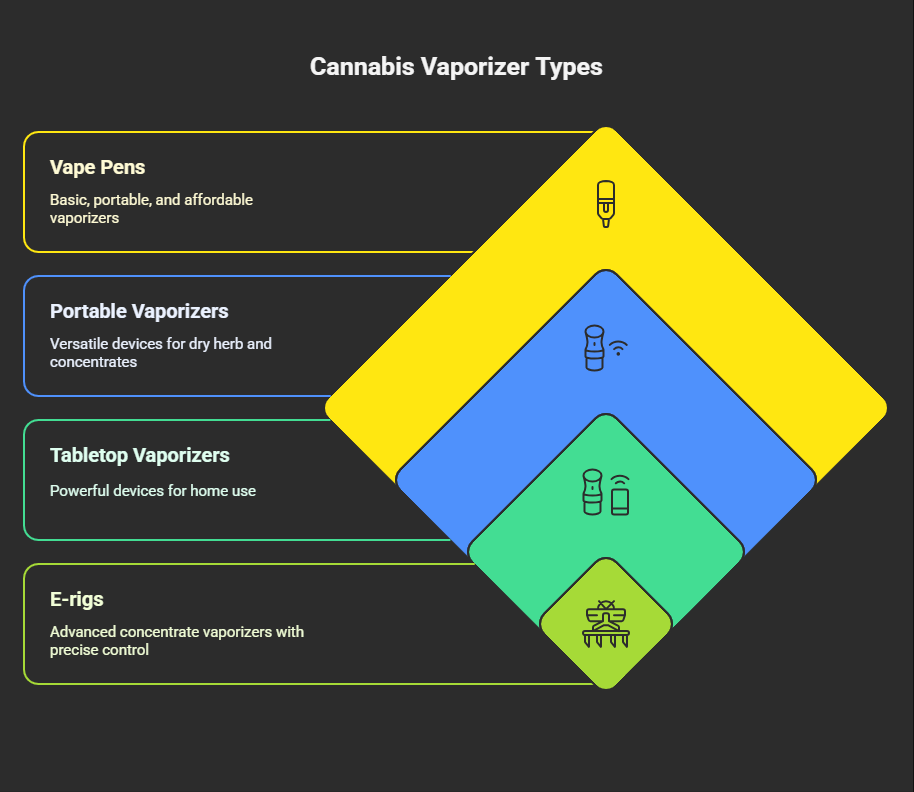
The market offers a wide variety of cannabis vaporizers to suit different needs and preferences:
- Vape Pens: These are the most popular type due to their ease of use, portability, and relatively low cost. They consist of a battery and a pre-filled or refillable cartridge containing cannabis oil. It’s crucial to purchase cartridges from licensed dispensaries to avoid potentially harmful additives Identifying safe vape cartridges.
- Portable Vaporizers (Dry Herb & Concentrates): These handheld devices are designed for vaporizing either dry cannabis flower, concentrates, or both. They offer more features than basic vape pens, such as temperature control and longer battery life. Popular models are known for their vapor quality and efficiency Vaporizer Reviews by The Vape Critic.
- Tabletop Vaporizers: Larger, more powerful devices designed for home use. They often utilize convection heating and can produce significant amounts of high-quality vapor. The Volcano is a classic example.
- E-rigs (Electronic Dab Rigs): Specifically designed for vaporizing concentrates, e-rigs offer precise temperature control and often include water filtration for smoother, cooler hits. They are a portable and electronic alternative to traditional dab rigs.
Vaping Cannabis Flower vs. Concentrates: A Comparative Analysis
The choice between vaping flower and concentrates depends on individual preferences and desired effects:
- Vaping Flower: This allows users to experience the full spectrum of cannabinoids and terpenes present in a specific strain, potentially leading to a more nuanced and strain-specific experience. Temperature control is particularly important for flower vaping, as different compounds vaporize at different temperatures, allowing users to tailor the effects of cannabinoid and terpene vaporization points
- Vaping Concentrates: Concentrates, such as oils, waxes, shatter, and diamonds, offer significantly higher potency levels compared to flower. They provide a more direct and intense experience and are often favored by those seeking strong effects or specific cannabinoid profiles. Different types of concentrates may require specific vaporizers or temperature settings for optimal vaporization.
Optimizing Your Vaping Experience: Temperature Matters
Temperature plays a crucial role in the vaping experience, affecting both flavor and the specific compounds that are vaporized:
- Vaping Flower Temperatures (325-430°F / 160-220°C): Lower temperatures (325-370°F) tend to preserve more delicate terpenes and produce a milder, more flavorful vapor with effects leaning towards the psychoactive and uplifting. Higher temperatures (370-430°F) will vaporize a broader range of cannabinoids, including more THC, leading to more intense effects but potentially sacrificing some of the nuanced flavors.
- Vaping Concentrates Temperatures (400-600°F / 200-315°C): Concentrates generally require slightly higher temperatures than flower. Lower temperatures in this range (400-450°F) are often preferred by flavor chasers, while higher temperatures (450-600°F) produce more vapor and a more intense hit. The myth surrounding “710” (OIL flipped upside down) being an ideal dabbing temperature is largely inaccurate, with excessively high temperatures often burning the concentrate and degrading its flavor and cannabinoid profile. Residual oil left after a dab is a good indicator that the temperature wasn’t too high.
Exploring the Potential of Already Vaped Bud (AVB)
When you vape cannabis flower, the material doesn’t fully combust into ash. Instead, it’s left as Already Vaped Bud (AVB), which is typically brown and dry. Surprisingly, AVB still contains residual cannabinoids and terpenes, although in lower concentrations than the original flower. AVB can be repurposed in various ways, most commonly for making edibles (as the cannabinoids have already been partially decarboxylated by the vaping process), infusing oils or butter, or even smoked or vaped again (though the flavor will be significantly diminished). The potency of AVB varies depending on the initial flower, the temperature it was vaped at, and the duration of the vaping session.
Safety Considerations and Responsible Cannabis Vaping
While often perceived as a safer alternative to smoking, responsible cannabis vaping involves several key considerations:
- Purchase from Licensed Sources: Always buy vape cartridges and devices from licensed and reputable dispensaries to ensure product safety and quality control. Counterfeit or black market products may contain harmful additives.
- Potential Health Risks: Research on the long-term health effects of vaping is ongoing. Be aware of potential risks and consume in moderation. Pay attention to any adverse reactions.
- Battery Safety: Use the correct chargers for your devices and avoid leaving batteries charging unattended or in extreme temperatures to prevent malfunctions.
- Device Maintenance: Regularly clean your vaporizer according to the manufacturer’s instructions to ensure optimal performance and prevent the buildup of residue.
- Understand Local Laws: Be aware of and adhere to the cannabis laws and regulations in your specific location regarding vaping.
See why Houston trusts “Singing Kush” for premium Cannabis products




★★★★★
4.4 from 1,400+ customers
“Daniel Contreras“
“Been coming here to this singing kush since 2023! It’s 2025 now AND I don’t plan on going anywhere else for my green. JIMMY IS RIDICULOUSLY KNOWLEDGABLE with like every single strain they have! It is super convenient since i dont have to waste money on flower that i might not like. If he doesnt like it, HE WILL TELL YOU and not BS YOU ! You rock jimmy!”
★ ★ ★ ★ ★
“Casey Baker“
“Jimmy at Singing Kush is really knowledgeable and always personable! Other staff are also incredible!”
★ ★ ★ ★ ★
“Luisa Martinez“
I love this place. There is no other employee like Jimmy. Hands down best customer service ever! He cracks me up!
★ ★ ★ ★ ★
“Brianna Ward“
“Fasho fasho gots to come back”
★ ★ ★ ★ ★
Cannabis Vaping: Frequently Asked Questions
Q. Is vaping weed healthier than smoking?
A. While many believe vaping to be less harmful due to the avoidance of combustion byproducts, long-term research is still needed. Vapor generally contains fewer harmful substances than smoke chemical composition of cannabis smoke vs. vapor, but potential risks associated with vaping exist.
Q. How long does a vape high last compared to smoking?
A. The duration of a vape high can vary depending on factors like dosage, potency, individual tolerance, and the specific cannabinoids and terpenes consumed. Generally, the onset of effects from vaping can be slightly faster than smoking, and the duration can be comparable, lasting anywhere from 1 to 4 hours.
Q. Will vaping weed make my clothes smell?
A. Vaping produces significantly less odor than smoking cannabis. The vapor dissipates more quickly and doesn’t cling to clothes and hair as strongly as smoke. However, there will still be some discernible aroma, especially during use.
Q. Can you vape any type of weed concentrate?
A. While many vaporizers are compatible with various types of concentrates (oils, waxes, shatter), some devices are specifically designed for certain forms. Check the manufacturer’s recommendations for your vaporizer.
Q. How do I clean my cannabis vaporizer?
A. Regular cleaning typically involves disassembling the device and using isopropyl alcohol and cotton swabs or brushes to remove residue from the heating chamber, mouthpiece, and other components. Refer to your device’s manual for specific cleaning instructions.
Q. What’s the difference between a vape pen and a portable vaporizer?
A. Vape pens are typically smaller, simpler devices primarily designed for pre-filled or refillable oil cartridges. Portable vaporizers are larger, more feature-rich devices that can often handle both dry herb and concentrates and offer more customization options like temperature control.
Q. Can I travel with a cannabis vape?
A. Traveling with cannabis vapes is subject to the laws of your origin and destination. Cannabis remains federally illegal in many countries and states, so it’s crucial to research and understand the regulations before traveling.
Q. What are terpenes and why are they important in vaping?
A. Terpenes are aromatic compounds found in cannabis that contribute to its unique smells and flavors. They also interact with cannabinoids and are believed to influence the overall effects of cannabis through the entourage effect . Vaping at lower temperatures helps preserve these delicate compounds.
Q. Are disposable vapes safe?
A. The safety of disposable vapes can vary depending on the manufacturer and the quality of materials used. Purchase from licensed sources and be wary of unregulated products. Battery safety and the quality of the heating element are key concerns.
Q. What does “full spectrum” mean in vape cartridges?
A. “Full spectrum” cartridges aim to retain a wide range of cannabinoids, terpenes, and other beneficial compounds present in the original cannabis plant, rather than isolating specific cannabinoids like THC or CBD. This is often associated with a more holistic and potentially more effective experience due to the entourage effect.
Conclusion | Cannabis Vaping
Cannabis vaping offers a modern and evolving way to consume cannabis, with potential benefits in terms of harm reduction, flavor, and discretion. By understanding the science behind vaporization, the different types of devices available, the importance of temperature control, and the safety considerations involved, users can make informed choices and optimize their vaping experience. As research continues and technology advances, cannabis vaping will likely continue to be a significant and innovative part of the cannabis landscape. Always prioritize responsible consumption, purchase from reputable sources, and stay informed about the latest developments in this dynamic field.
